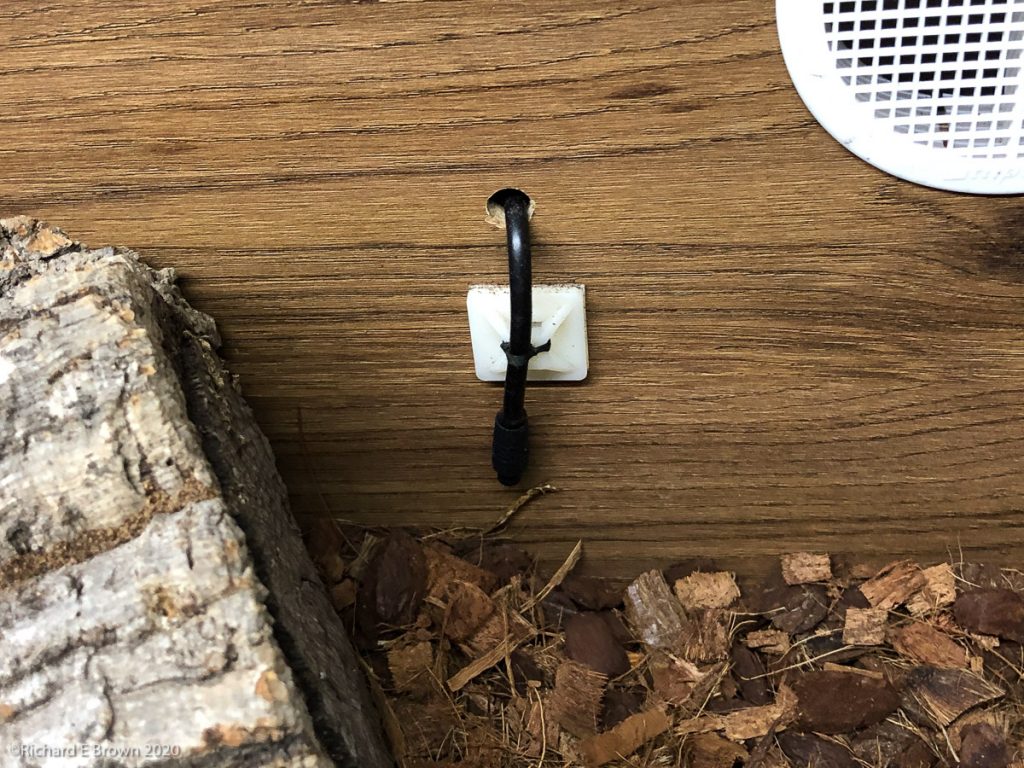
Bertie has quite a vivarium, one that I thought had enough redundancy to protect him. The substrate is a base of coarse and fine coco substrate and orchid bark giving a mix of textures and the ability to hold moisture and release it slowly without feeling wet.
On the power side, there are two independent power sockets each feeding a six way with surge protection.
There are three lighting systems, a high intensity UV that I run from midday to four in the afternoon, a daylight LED system on a timer giving eight hours in the winter and up to fourteen hours in high summer. There is also a coloured light for dusk. All these are on separate digital timers.
The vivarium has two 150 watt heaters, one in the middle on its own controller giving a background day temperature and a different background night temperature, plus one at the far end giving the hotspot.

The brown out earlier in the week had blown both controllers (I now know just the fuses), and one of the ceramic heaters. Despite my precautions of separate power and surge protection we had lost all the heating.
As a temporary measure I hooked up a 50 watt infra bulb and a spare controller and thermostat and set the room radiator to be permanently on instead of it timing mode. I ordered two new controllers and new heaters, and a set of fuses.

replacing thermostat 
thermostat probe
Replacing the controllers and thermostat probes was the easy part. The old controllers together with the extra heaters will act as spares.
The heating units were more of a challenge, I replaced both the ceramic holders and the ceramic heaters.
While all this was going on we removed the glass front to the vivarium so had the room radiators on high and we had the fire on. This made the room hot for us so we were working in tee shirts but Bertie was comfortable.
Temperature Data
Wild boas have been recorded active at temperatures as low as 62°F (17°C) and up to 104°F (40°C) between the hours of 7am and 7pm, although most of the data is clustered between 90°F (32°C) and 66°F (19°C). This temperature range contradicts what most keepers assert as “the best,” but proves that with correct husbandry, these animals are hardier than previously thought. Do you think that nature always stays at the perfect temperature? Of course not, and these animals are adapted to deal with the fluctuations of their region without getting sick. The key is to create a full temperature gradient so your snake can warm up and cool down as desired. The hottest areas will be closest to the heat source, and the coolest areas will be farthest from the heat source.
- Chiaraviglio, Margarita, et al. “Intrapopulation variation in life history traits of Boa constrictor occidentalis in Argentina.” Amphibia-Reptilia 24.1 (2003): 65-74.
- Waller, Tomas, et al. “Ecological correlates and patterns in the distribution of Neotropical boines (Serpentes: Boidae): a preliminary assessment.” Herpetological Natural History 3 (1995): 1.
- McGinnis, Samuel M., and Robert G. Moore. “Thermoregulation in the boa constrictor Boa constrictor.” Herpetologica 25.1 (1969): 38-45.
Thanks to the ReptiFiles https://www.reptifiles.com/red-tailed-boa-care/boa-constrictor-temperatures/
